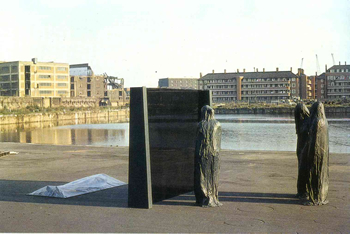“HORIZON” 1970

ART PRESS The sculpture is especially fascinating and none more so than Rose Garrard's 'Horizon' - a marvelous object consisting of an upright sheet of black, translucent Perspex, on one side of which lies a cast of a nude woman, and on the other stand three shrouded female figures. The glass fuses the elements (including the observer) by transmitting or reflecting objects on either side of itself and is superbly disturbing.
Arts Review, May 1970
ARTIST'S NOTES On my first day of the Post-Graduate course I found I was one of eight sculpture students, with only one other woman. We talked and discovered we had each just got married, but were both apprehensive about disclosing this to the all male staff. To support each other we went together to tell the head of the course George Fullard, who was furious, but relatively speechless as he didn't seem able to put the reason for his anger into words.
Having a husband did reduce my social life in the evenings at college, which when combined with the intensity of my usual work pattern, was regarded as unfeminine behaviour by some. One staff member commented "So you're going to be a dyke like Frink?" which I took to mean she had been a very committed worker while at Chelsea, though the inference that this was not considered a heterosexual way for a woman to work was not lost on me. I struggled to shake off the feeling of disempowerment, but it was a way of seeing the successful woman-as-artist which I never forgot.
The Kings Road was still part of the swinging sixties and walking down it each evening, my clothes covered in dust or encrusted with plaster and resin, I felt an outsider, not feminine enough for this fashion world, not masculine enough for the world of sculpture. The shop window reflections and this feeling of being watched and evaluated influenced the piece, though at the time I was most conscious and concerned to talk about the less personal level of content which dealt with the world-wide abuse of human rights.
'Horizon' was my first major piece here and I considered it whole only when spectators were present, seeing themselves occupying a voyeuristic role, witnessing the transfer of their own reflected image into the sculpture. Though divided in space the images unified in the screen and appeared to surround the fibreglass nude model who was lying veiled under a translucent cover. The search for 'an authentic female self beyond the empire of male signs' has engaged me ever since.
Rose Garrard 1994
SITES
'Post Graduate Show' Chelsea School of Art London
'First Show' Serpentine Gallery London
'Summer Summary' Alwin Gallery London
'Space Open Studios' St Katherine's Dock London
COMPONENTS
One lying fibreglass and three standing plaster figures with smoked Perspex screen.